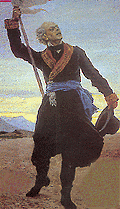 ¡Mexicanos, viva México! Every year at midnight on September 15, Mexicans shout El Grito de Dolores.
¡Mexicanos, viva México! Every year at midnight on September 15, Mexicans shout El Grito de Dolores.This title is a pun in Spanish. Grito de Dolores can mean “The Shout from (the town of) Dolores” as well as “The Cry of Pain,” signifying the pain that the rule of Spain caused Mexico for three centuries.
Just before dawn on September 16, 1810, Miguel Hidalgo y Costilla made a decision that revolutionized the course of Mexican history.
A Catholic priest in the village of Dolores, Hidalgo ordered the arrest of Dolores’s native Spaniards. Then he rang the church bell as he usually did to call the Indians to mass.
The message that Hidalgo gave to the Indians and mestizos called them to retaliate against the hated gachupines or native Spaniards “who had been exploiting the wealth of the Mexican people with the greatest injustice for three hundred years.” Hidalgo’s fervent Grito was a passionate, unplanned decision.
Although a movement toward Mexican independence was already in progress since Napoleon’s conquest of Spain, Hidalgo urged the exploited and embittered Mexicans to recover the lands that were stolen from their forefathers. He called these people to revolution – a radical change in the original, more gradual plot devised by the criollos (Mexican-born Spaniards).
Hidalgo and El Grito spurred a long, violent social earthquake, almost without precedent in New Spain or the Americas: the Mexican War of Independence – a truly popular movement led by four hundred armed parish priests.
¡Mexicanos, viva México!
El Grito has particular significance today. First, Mexico is still roiled after its recent, contested presidential election. “Leftist protests forced Mexican President Vicente Fox to abandon plans to lead a traditional ceremony in the capital on Friday, the eve of independence day, the Interior Minister said.
“Fox, targeted by leftists angry at what they say was fraud at July's presidential election, will instead hold the highly-symbolic cry of independence in the central town of Dolores Hidalgo, minister Carlos Abascal told reporters on Thursday.”
Second, there’s the report from Princeton University and UC Irvine on Wednesday: “A few generations after families move to the United States from Latin American countries, fluency in Spanish dies out and English becomes the dominant language, according to a new paper published by sociology professors from New Jersey and California.” (See post above, Saturday, September 16.)
The report has raised its own ruckus…but not if you believe that America is really a melting pot (instead of a tossed salad). Almost 200 years after Padre Hidalgo in Dolores, El Grito still has meaning, still has force – it’s becoming part of our own national fabric as well as Mexico’s.
History inevitably connects us all. Better study it so you know what really moves people.
¡Mexicanas y Mexicanos, viva México!
Sources: the outstanding Mexico: Biography of Power by Enrique Krauze; Wikipedia; Reuters; International Herald Tribune. Illustration from www.redescolar.ilce.edu.mx.
No comments:
Post a Comment